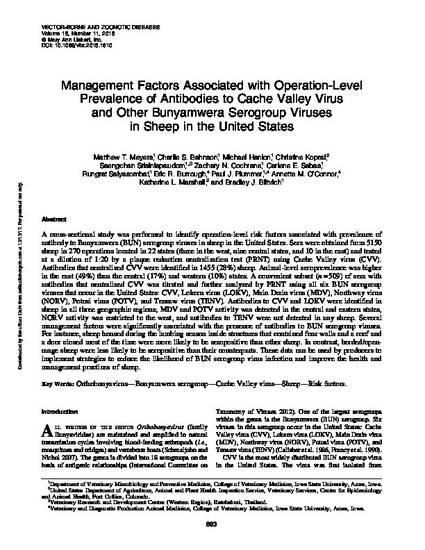
A cross-sectional study was performed to identify operation-level risk factors associated with prevalence of antibody to Bunyamwera (BUN) serogroup viruses in sheep in the United States. Sera were obtained from 5150 sheep in 270 operations located in 22 states (three in the west, nine central states, and 10 in the east) and tested at a dilution of 1:20 by a plaque reduction neutralization test (PRNT) using Cache Valley virus (CVV). Antibodies that neutralized CVV were identified in 1455 (28%) sheep. Animal-level seroprevalence was higher in the east (49%) than the central (17%) and western (10%) states. A convenient subset (n = 509) of sera with antibodies that neutralized CVV was titrated and further analyzed by PRNT using all six BUN serogroup viruses that occur in the United States: CVV, Lokern virus (LOKV), Main Drain virus (MDV), Northway virus (NORV), Potosi virus (POTV), and Tensaw virus (TENV). Antibodies to CVV and LOKV were identified in sheep in all three geographic regions; MDV and POTV activity was detected in the central and eastern states, NORV activity was restricted to the west, and antibodies to TENV were not detected in any sheep. Several management factors were significantly associated with the presence of antibodies to BUN serogroup viruses. For instance, sheep housed during the lambing season inside structures that contained four walls and a roof and a door closed most of the time were more likely to be seropositive than other sheep. In contrast, herded/open-range sheep were less likely to be seropositive than their counterparts. These data can be used by producers to implement strategies to reduce the likelihood of BUN serogroup virus infection and improve the health and management practices of sheep.
Available at: http://works.bepress.com/paul-plummer/32/

This article is published as Meyers Matthew T., Bahnson Charlie S., Hanlon Michael, Kopral Christine, Srisinlapaudom Saengchan, Cochrane Zachary N., Sabas Carlene E., Saiyasombat Rungrat, Burrough Eric R., Plummer Paul J., O'Connor Annette M., Marshall Katherine L., and Blitvich Bradley J.. Vector-Borne and Zoonotic Diseases. November 2015, 15(11): 683-693. doi: 10.1089/vbz.2015.1810. Posted with permission.